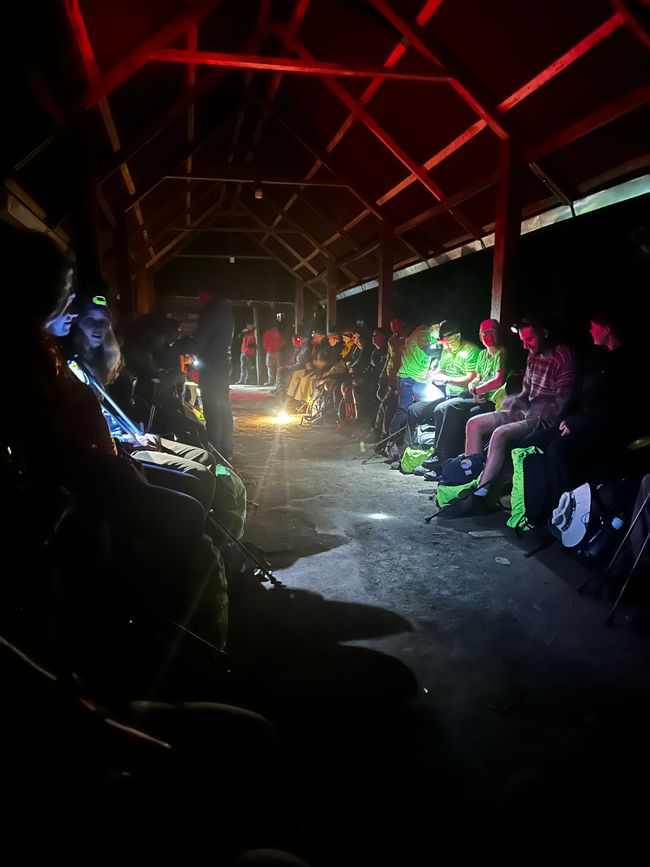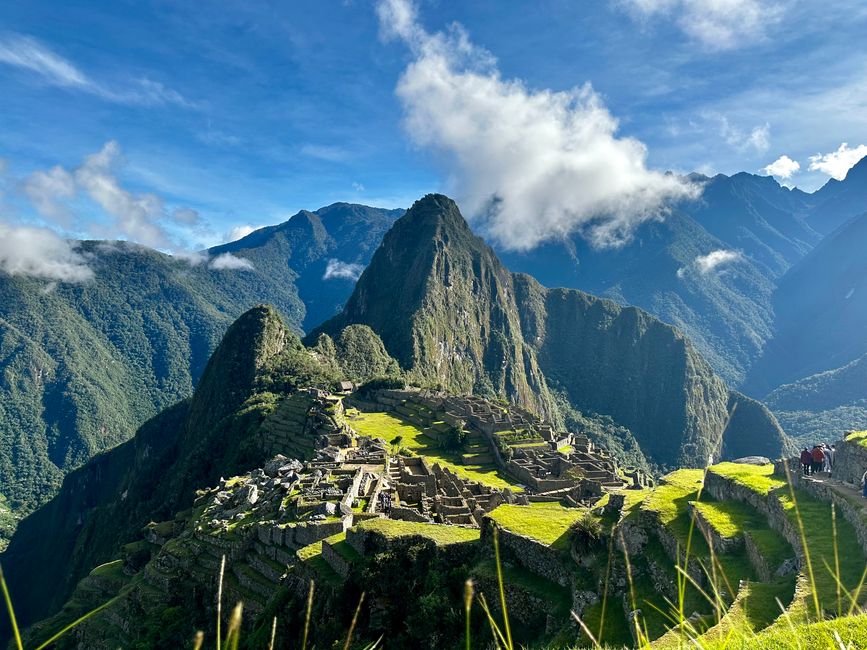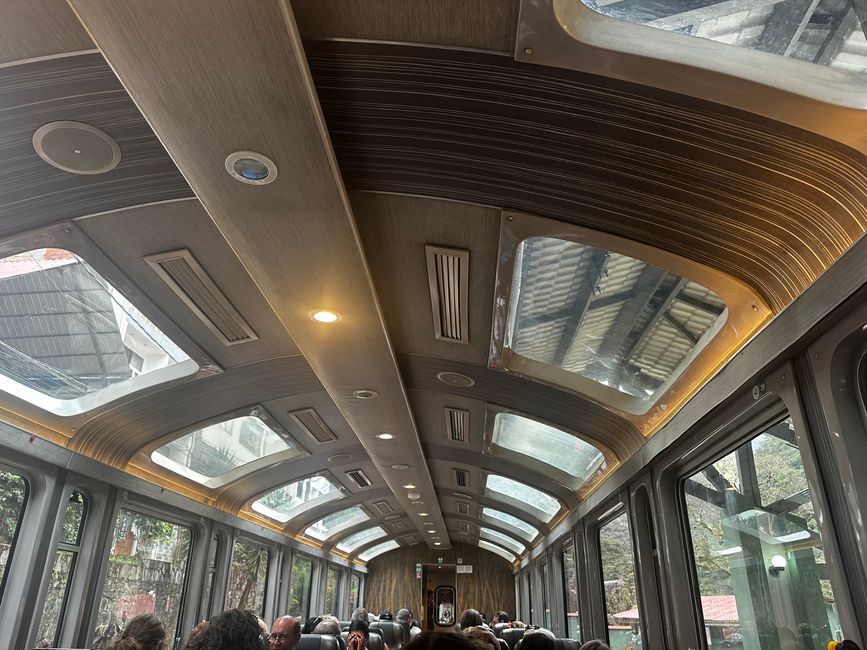Machu Picchu
ޝާއިޢުކޮށްފައިވެއެވެ: 20.05.2024
ނިއުސްލެޓަރ އަށް ސަބްސްކްރައިބް ކޮށްލައްވާ
Since we had a short day yesterday, we were able to go to bed early enough to not be as tired at 2:50 AM as the time might suggest. We pack everything until 3:20 AM, receive a breakfast package, and set off with headlamps to Checkpoint Wiñaywayna, where we arrive at 3:30 AM. There is a large carport with benches in front of the gate where we wait for the next two hours until we are allowed to start walking to the Sun Gate at 5:30 AM. During the two hours, I try to get some more sleep. When the light turns on at 5:20 AM, the excitement rises. We are the third group and the passport control goes surprisingly fast. Now we are allowed to go at our own pace. Abelardo warns us that there may be trouble on the way when it comes to overtaking, but luckily I can't confirm that. During the next 50 minutes, I overtake a few groups who take a short break on the way, and everyone is very friendly. After all, we all arrive at Machu Picchu and the hike during sunrise is too beautiful to be annoyed. The last section is a rather steep staircase that we almost have to climb and suddenly I find myself on a small stone platform. Without warning, I am suddenly there, at the Sun Gate (Intipunku), and I look at Machu Picchu for the first time. I can hardly describe all the thoughts that go through my head in that moment; a mixture of amazement, happiness, and relief overwhelms me. I have been waiting for this moment for so long, let alone the efforts of the last few days, and here it is now. None of my expectations were too high, I am simply overwhelmed.
Since I am one of the first in our group, I have almost an hour to process all of this and enjoy my breakfast with a view of Machu Picchu. I am happy to see other hikers as well, who are impressed by this sight and to see the emotions and joy of everyone we have met again and again on the Inca Trail over the past few days.
The final path to Machu Picchu, first to the point where THAT photo is taken, takes another 30 minutes and again and again gaps between the trees allow a view of Machu Picchu, which I can hardly turn away from. I turn off airplane mode on my phone for the first time and when I see that I have great internet here, I call my family via FaceTime to share this moment with them. That also feels incredibly good; my excitement has to go somewhere.
After said 30 minutes, I arrive at the viewpoint and luckily we have enough space and time to admire this incredible Inca city. The tourists who take the bus to Machu Picchu have a terrace above from which the photos can be taken. But the closer terrace is exclusive to the groups of the Inca Trail; another reason why the last four days have been worth it.
After the photo session, we leave the site to visit the lower part. We sit on one of the terraces that was used for cultivation in the past, and Abelardo tells us about Machu Picchu.
According to research, the city was built in 1450 by the Inca ruler Pachacútec Yupunqu - 5,000 to 10,000 workers were involved in the construction of Machu Picchu. When this city was discovered in 1911 by Hiram Bingham, no one knew what the Inca called this city in the past, so the discoverer named it after the mountain on which it is located: Machu Picchu (= old mountain). At an altitude of 2,430 meters, up to 1,000 people lived here during the height of the Inca civilization. Since there are no records, only assumptions can be made about the purpose of the city. Based on various excavations and architectural structures, Machu Picchu was certainly a place for administration, religion, and military. For the Inca upper class, there was also a large building complex which is said to have served as a kind of "university".
When the Spanish invaded the Andes, the residents of Machu Picchu also fled to Vilcabamba, the last Inca site, in 1536, and Machu Picchu was forgotten.
As we look at the surrounding mountains, we also discover Intipunku, the Sun Gate, again. The name comes from the fact that on December 21, at sunrise, the light through the Sun Gate falls precisely on a window of the Temple of the Sun in Machu Picchu. According to measurements by NASA, research confirms that Machu Picchu and Intipunku are one of the most accurate astronomical points on Earth. It is amazing what the Inca already knew in the 15th century. In 1983, Machu Picchu became a UNESCO World Heritage Site and since 2007, Machu Picchu has been one of the Seven Wonders of the New World - and I have now ticked off 4 out of 7.
After learning more about the Inca and this wonderful city during our tour, we take the bus to Aguas Calientes, where we have lunch together before heading to the train station with our backpacks and duffel bags. Here we take the Vistadome, which takes us to Ollantaytambo in 1.5 hours. The tables in the train are decorated with colorful tablecloths and we enjoy the view from the windows and the roof windows above us during the journey. When we start, we notice that we don't seem to be sitting in a normal compartment: the entire trip has Peruvian music, there is dancing in the aisle, and Peruvian fashion is presented. Time flies by.
When we arrive in Ollantaytambo, we board our bus, a VS30 Sprinter (!), and start the return journey to the TreXperience office, from where we will be taken to our accommodations. When I arrive at my hotel at 8:00 PM, tiredness sets in. After all, today was a long, exhausting, but wonderful day - also the reason and highlight of this entire trip!
ނިއުސްލެޓަރ އަށް ސަބްސްކްރައިބް ކޮށްލައްވާ
ޖަވާބު

ދަތުރު ރިޕޯޓްތައް ޕެރޫ އެވެ









